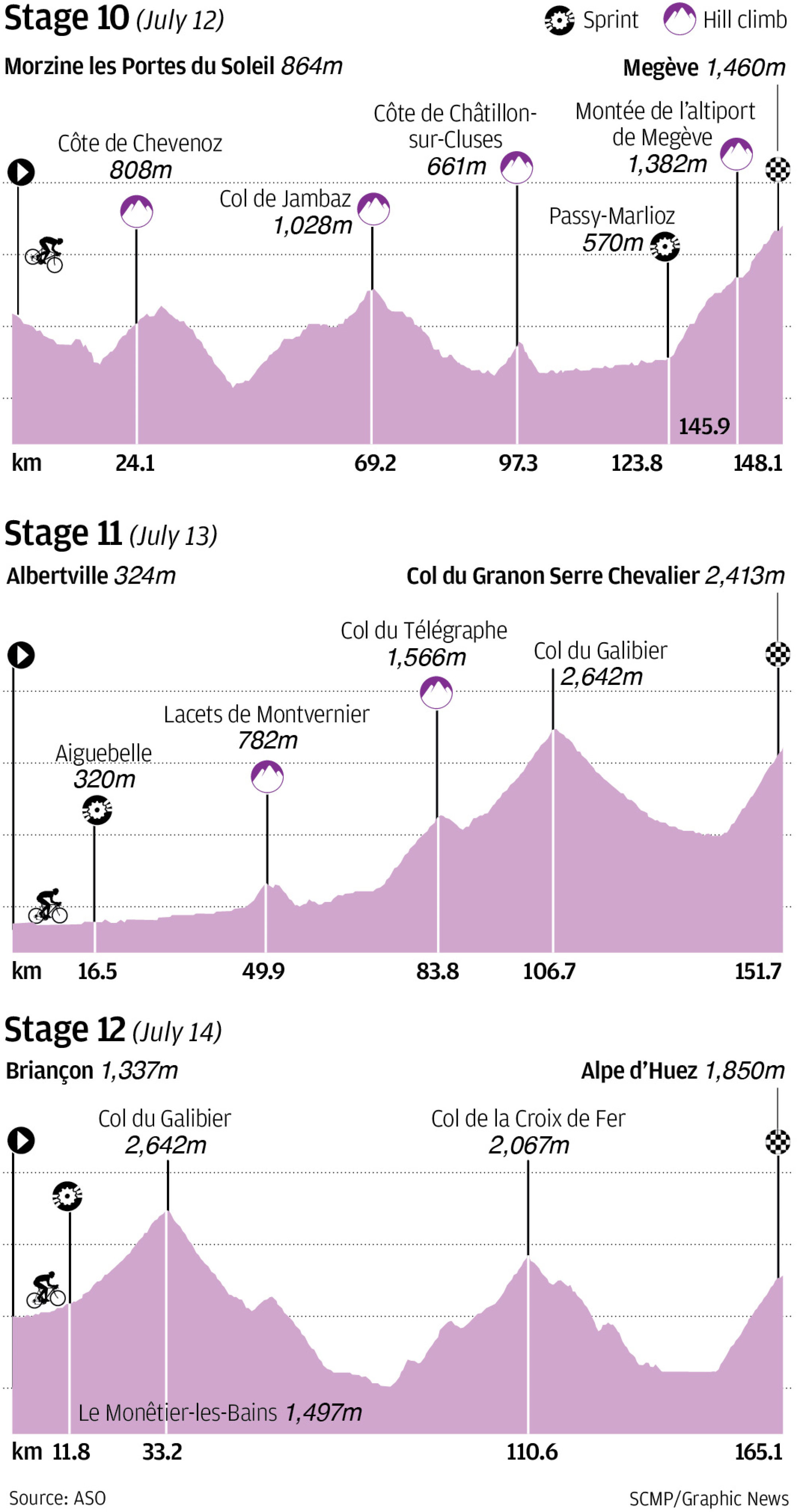
As Tour de France enters the Alps, here are the climbs that will separate the winners from the also-rans
- From the imposing Col du Galibier to the brutal challenge of the Alpe d’Huez, stages 10 through 12 will be gruelling affairs
- Mountain stages were first introduced in 1910, seven years after the first race
It’s the second week of this year’s Tour de France and the mountain climbs the race is famous for are about to separate those who aspire to win the yellow jersey and the rest.
Luxembourg’s Bob Jungels won the first Alpine finish of this year’s race on Sunday, cruising across the finish line 22 seconds clear on the mountainous 193km (120-mile) stage nine route from Aigle in Switzerland to the ski resort of Châtel les Portes du Soleil.
A rest day on Monday will be followed by three consecutive Alpine mountain top finishes as the riders desperately jostle for position in the overall standings on climbs such as the gruelling Alpe d’Huez.

Stage 10 runs from Morzine to Megeve, stage 11 Albertville to Col du Granon and stage 12 from Briancon to Alpe d’huez.
Defending champion Tadej Pogacar said the third of the three looked toughest but all of them were hard.
“Galibier is so long but Alpe d’huez is so steep and so long, it’s the hardest stage,” he said of the Queen stage, which is on the French national holiday on July 14.
Mountain stages were first introduced in 1910, seven years after the first race, and riders braved the unpaved roads of the Pyrenees on single speed roadster bikes, which was when the now-standard grading system of climbs was conceived, based on the gear needed by the cars following to scale the mountains.
The Alps were added in 1911, and each year the route and the climbs used in the Tour vary, and while some of the big names of the past are missing, this year’s challenge is no less fearsome.
Tuesday’s stage in the Alps, a 148.5km ride from Morzine to Megève skirts the biggest climbs; with much more to come, the favourites are likely to mark each other, with a big battle for the stage win from an early break. The 19km drag to the finish is where it will all happen; that will favour the likes of France’s Warren Barguil or Mathieu van der Poel.
A brutal day follows on Wednesday, with a 152km race from Albertville to Col du Granon and a stage that features two big climbs in the final 80km and the imposing Col du Galibier.
Consider one of the toughest and highest of Alpine climbs, it is hardest when tackled from the Col du Telegraph side, which means scaling two big cols without any respite.
Topping out at 2,646m and with an average gradient of 6.1 per cent for some 18km, and it features on both stages 11 and 12 this year, in opposing directions). The Galibier first hit the Tour in 1911, when only three riders managed to avoid walking during the ascent.
The length of the main climbs means the break is unlikely to succeed, so the overall favourites may well fight out the stage win: if a contender such as Pogacar or Jonas Vingegaard wins here, they will be in pole position for the final title.

If climbing the Galibier wasn’t punishment enough, this year’s Tour makes the riders go back the way they came as they cross the Croix de Fer to tackle l’Alpe d’Huez for the first time in four years.
Stage 12 is a 165.5km slog from Briançon to Alpe d’Huez, and is perhaps the ultimate place of pilgrimage for all cycling fans. It returns to the Tour for the first time since 2018.
The climb is 13.8km long, and the gradient is an average of 7.9 per cent, with 21 famed hairpins along the way to the 1,860m high summit.
Countless epic battles have been fought on this climb. In 1986 Greg Lemond and his teammate, nemesis, and the patron of the peloton Bernard Hinault crossed the line hand in hand, with Lemond winning the stage and then the Tour.
Before that though comes the Col de La Croix de Fer. The “iron cross” can be approached from many directions, with the most challenging being to combine it with a crossing of the Col du Glandon, it’s near twin peak.
A very narrow road climbs through the valley, which is 22km long when combined with the Glandon, or 31km the “easy” way. Via the Glandon the gradient averages 7 per cent to reach the 2,067m high summit. The climb first appeared on the 1947 Tour and because of its location, it usually features mid-stage, hence is always part of a long grinding ride.
